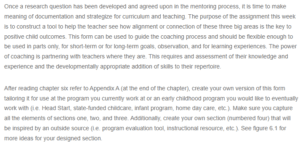Curriculum Planning Form
| I. Section One– my broad goal is to develop a warm and supportive environment and relationship that ensures early childhood learners’ emotional, social, psychological and physical development.
My goal was influenced by a professional source or reference “Developing mentoring and coaching relationships in early care and education”: A reflective approach. Pearson Higher Ed, (Chu, Marilyn, 2013). |
|
| Specific teacher Objective | Specific child(ren) Objective |
| 1. What is the one short-term objective I desire to achieve? | 1.What should I expect from the learners?
How will I adjust to the required learning levels of the children? |
| 2. What steps should be initiated to make the goal/ objective achievable? | 2. How will I adjust the curriculum for my learners to understand whatever I teach them? |
| 3. What challenges will deter me from achieving this duty? | 3. What core values or standards are required to teach the learners? |
| II. Section Two- Assessment Evidence | |
| How will the data or information from the assessments be used to improve the skills of the learner?
What materials will be required to complete the task? How will the regression and progression of the learners be documented? What modifications can I apply to the assessments to ensure that the learner will memorize the knowledge of the taught lessons? |
|
| A. Teacher Evidence | B. Children Evidence |
| Before:
What teaching technique have I tried? Was any of the methods or strategies successful? The usage of peer observation and observation. |
Before:
What are the learner’s needs? Do learners apply whatever they are taught in the daily lesson? What are the students’ learning tendencies? Does the learner need intervention? |
| After:
Is there any available evidence to ensure that the students or the teacher achieve the set goals? |
|
| III. Section Three: Learning Experience | |
| A. Teacher strategies | B. Children Experiences |
| Before:
What are the most efficient and best teaching strategies that I can employ? How much time will it take to implement these teaching methods or strategies? |
Before:
Do the students enjoy learning? Do the learners get distracted while learning? |
| After:
Was the set goal accomplished? Which teaching strategy was best among those used? Were the students’ attention maintained? How many hands-on time activities were spent on each learner? |
After:
What were the results after every lesson? Were learners motivated to learn more? How was the evidence collected from the classwork and assessments used? |
| Learning Activities/ Instruction Strategies | |
| What necessary steps can I implement to ensure that the goal is accomplished?
Did I appropriately interact with the learners during lesson time? Resources What materials or resources will be required? Final Reflection Do you feel you succeeded in teaching your learners? Do you think your learners memorized the knowledge taught? What was your most important activity? Did you have to execute any changes in the middle of your lessons? What did you modify, if there were any modifications? |
|
| IV: Section Four: Evaluation
The Early Childhood Classroom Observation Measure (ECCOM), D. Stipek & P. Byler, Stanford University School of Education will be used. What program and child observation tools do the teacher use and understand? How would you evaluate the learners? What was the greatest challenge in evaluating the learners? Was the learners’ level of understanding determined by the type of assessment or evaluation used? What convinced you that the learners understood what they were taught? |
|
References
Chu, M. (2013). Developing mentoring and coaching relationships in early care and education: A reflective approach. Pearson Higher Ed.
Stipek, D., & Byler, P. (2004). The early childhood classroom observation measure. Early Childhood Research Quarterly, 19(3), 375-397.
ORDER A PLAGIARISM-FREE PAPER HERE
We’ll write everything from scratch
Question
Once a research question has been developed and agreed upon in the mentoring process, it is time to make meaning of documentation and strategize for curriculum and teaching. The purpose of the assignment this week is to construct a tool to help the teacher see how alignment or connection of these three big areas is the key to positive child outcomes. This form can be used to guide the coaching process and should be flexible enough to be used in parts only, for short-term or for long-term goals, observation, and for learning experiences. The power of coaching is partnering with teachers where they are. This requires and assessment of their knowledge and experience and the developmentally appropriate addition of skills to their repertoire.

Curriculum Planning Form
After reading chapter six refer to Appendix A (at the end of the chapter), create your own version of this form tailoring it for use at the program you currently work at or an early childhood program you would like to eventually work with (i.e. Head Start, state-funded childcare, infant program, home day care, etc.). Make sure you capture all the elements of sections one, two, and three. Additionally, create your own section (numbered four) that will be inspired by an outside source (i.e. program evaluation tool, instructional resource, etc.). See figure 6.1 for more ideas for your designed section.

